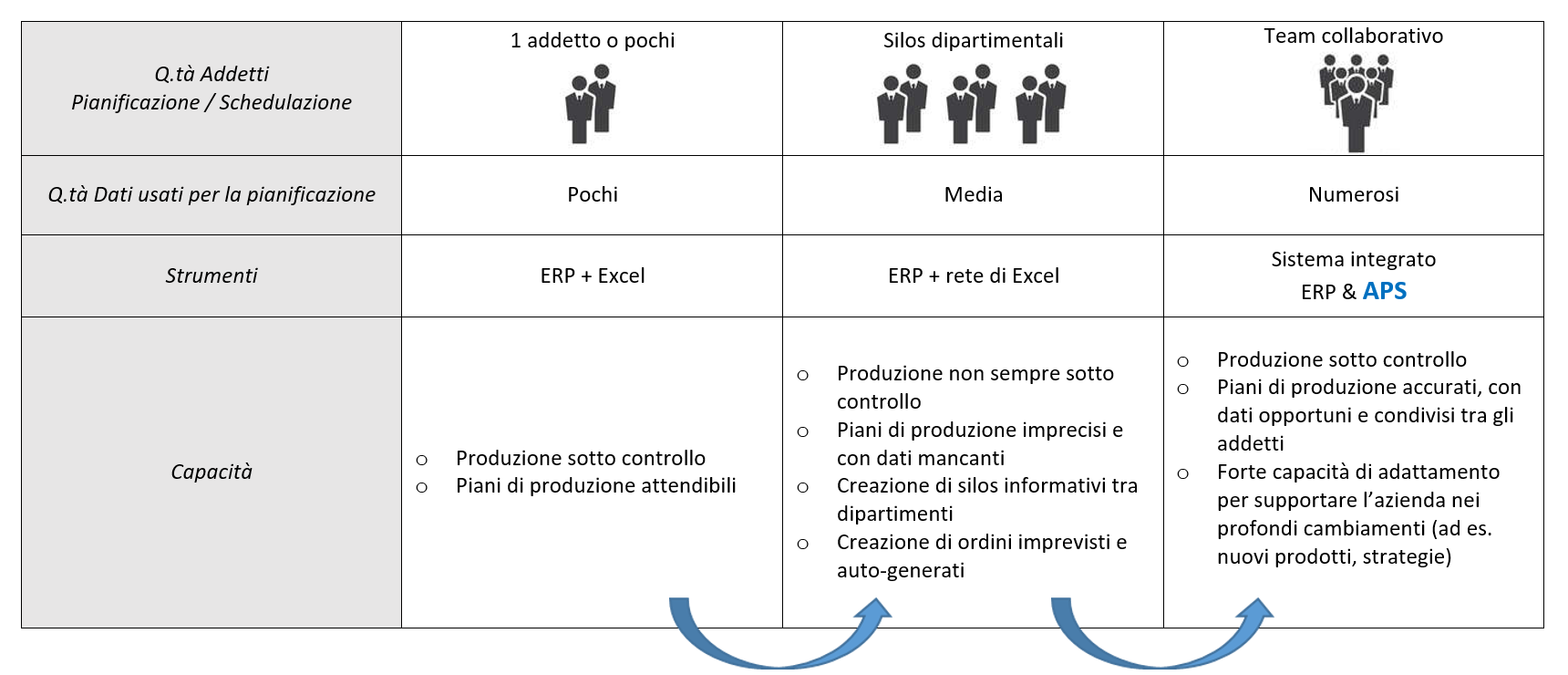Companies are not all equal to each other and they are not equal to themselves, if observed in their growth path. They, in fact, go through different evolutionary steps, and this is also true with regard to the production planning of manufacturing companies.
It is evident that the needs in terms of production planning of a small company are not the same as those of a large multinational company that has several production plants located in different countries, which speak different languages and have different time zones, each with its planning and scheduling managers.
In addition to this, it must be taken into account that a linear growth in the size of the company corresponds to a more than proportional increase in the complexity and the amount of data that must be managed.
What are the main growth stages of production planning?
Manufacturing companies have a growth path of production planning that can be analyzed taking into account different characteristic aspects: personnel, amount of data used for planning, tools used to support and capacity of the department itself. Taking these factors into account, it is possible to divide the growth path into 3 main phases.
In the first phase, production planning involves one or a few employees managing a limited amount of data. At this stage, production is easily kept under control and quite realistic production plans are generated with tools such as ERP and Excel files to support it.
Companies that are in the second phase have a planning department composed of several employees who deal with planning and scheduling. In this phase, a greater amount of data is managed than before and the ERP is surrounded by a large number of Excel files, which cause departmental information silos between the different colleagues and employees who encounter various difficulties in communicating with each other on a daily basis. Plans that are not always precise and realistic cause the lack of production control that is often found to produce unforeseen and self-generated urgent orders.
In the third phase, the company has a team of people who plan the company’s production, using a large amount of data thanks to an integrated system composed of ERP and APS (Advanced Planning and Scheduling software). These integrated tools allow the company to have production under control and to generate feasible and shared plans among colleagues. This system allows the company to adapt to the adoption of new strategies and the arrival of new products.
Do you know where you want to go
It is therefore useful to analyse where you are in order to be able to act on the appropriate areas and to be able to better focus on current and future needs. By looking at the graph you can assess what stage our company is in and what the current needs are, as well as what the future ones will be. This analysis is not always simple and immediate. What can help is to ask yourself the following questions:
- How much data do you have available for planning?
- How many of these are actually used for planning?
- How many Excels does your company use to plan?
Usually companies that use less than 75% of the available data to plan tend to lose a true perception of what is happening in the production department.
Companies that use more than 3/5 Excel/Project files per department for planning purposes, tend to lose the overview facilitating the creation of silos. The added value of collaboration and integration between systems is thus lost.
After analyzing the available data and their use, we proceed with an analysis of the efficiency of process management:
- Do you think your service level can be improved?
- Do you think the missing problem can be reduced?
- Do you think inventory turnover can be optimised?
- Does your company often face emergencies in production?
If you answered yes to at least 3 of the above questions, it is highly likely that your business will benefit substantially from advanced planning and scheduling software.
Consider using an APS
Observing the current situation, it is therefore easy to predict future needs and requirements, among which it is clear that a leading role is played by advanced APS planning and scheduling software, capable of reasoning at finite capacity. This potential allows companies that use them to create feasible plans, based on the real possibilities of the company and its natural physical and temporal constraints.
“Growth is never by mere chance; it is the result of forces working together.” – James Cash Penney, Founder, JC Penney
APS software also provides the possibility of sharing production plans between colleagues located in different countries, providing the necessary requirements for companies that intend to seize future opportunities and breaking down silos that are an obstacle. Finally, the graphic capabilities of these solutions allow a quick and simple analysis of what is happening and will happen in the supply chain, at different levels. The human being is not able to carry out such analyses, especially at the levels of detail and with the breadth of vision offered by these powerful tools.
Numerous testimonials of performance improvement
Many companies are already planning their production thanks to the APS CyberPlan software:



